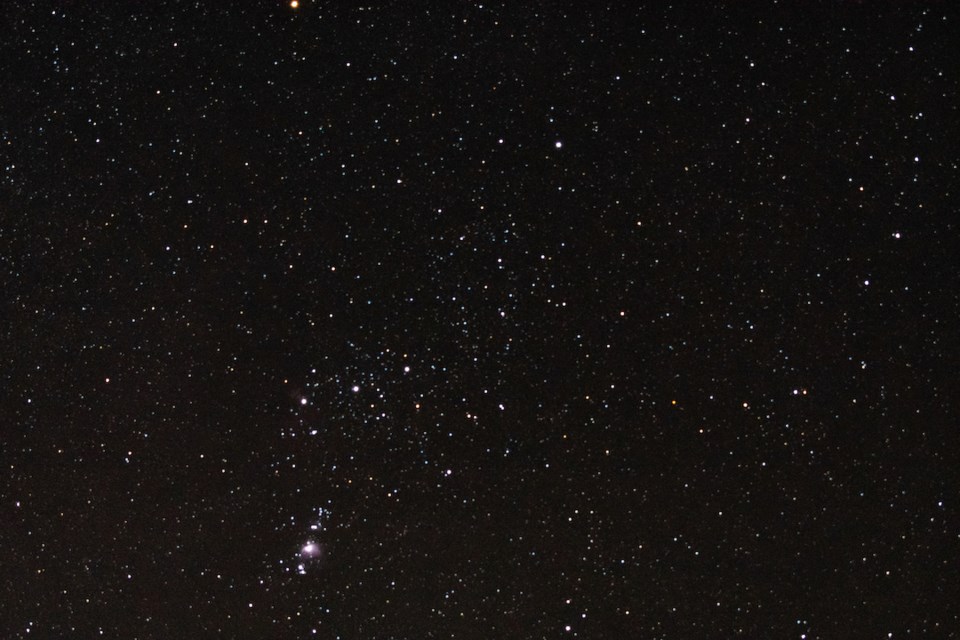I hope everyone enjoyed the trivia tour of Orion. My two articles barely scratched the surface, however, and there are enough interesting things in and around Orion to bore people to tears. I’ll finish by pointing out the sky around Orion and then you’ve got about half the northern hemisphere in your head. Note – in order to help with stellar pronunciations, I’ve underlined the emphasized syllable.
I covered the bright massive stars Betelgeuse and Rigel at the upper left and lower right corners of Orion in my first article. Find the three Belt stars between them; they point roughly down and east (left) to a bright star – brightest in our sky, in fact – known as Sirius, the bright star in Canis Major. It’s a binary system only 8.6 light years (ly) from us, one of the closest stars. There is a bright A-class star about twice our sun’s mass along with a faint companion white dwarf orbiting it about as far away as Neptune is from our sun. It’s estimated the system is about 200-300 million years old and the white dwarf is the remains of a bigger star that expanded into a red giant, blew off its outer layers and began to cool and die as a white dwarf.
If you visualize Sirius and Betelgeuse as two points of an equilateral triangle, you’ll see another bright star up and to their left roughly equidistant from both. This is Procyon, the bright star in Canis Minor, a star about 50 per cent more massive than ours, hotter and likely starting to turn into a reddish subgiant. It’s about 14 ly away and it too has a white dwarf binary companion, somewhat smaller than Sirius B, that orbits it every 40 years or so. Trivia note – The genus ‘procyon’ contains all of the known species of raccoons. Why the bright star in Canis Minor – the ‘lesser dogs’ – should be named after raccoons is a mystery to me.
Next, move clockwise around Orion to a close pair of stars about equally bright and just east of a line from Rigel through Betelgeuse. The eastern star is Pollux; the western is Castor, the two bright stars in Gemini, The Twins. If you forget which is which: Pollux is closer to Procyon; Castor is closer to Capella (to its right).
Pollux is a red-orange giant star 34 ly distant, about twice the sun’s mass and about nine times its diameter. It has expanded and cooled as it fuses heavier elements in its core. Originally a white Type A star, it is destined to die as a white dwarf. It is believed to have a planet more than twice Jupiter’s mass orbiting every 600 days or so.
Castor is 54 ly distant, then it gets messy. There are two Type A stars each about two solar masses orbiting each other and each of them with a close white dwarf – a spectroscopic binary. But wait – there’s more: about a light year or so away there is another pair of red dwarf stars that orbit each other and together the other four. Each of the two big stars’ dwarf companions orbit them with periods in days, the two big ones orbit each other with a period of about 450 years and the little red guys orbit each other daily and orbit the other two pairs every 14,000 years or so. Whew.
Next to clockwise is Capella, the bright star in Auriga, The Charioteer. Naturally, it’s another multiple system – quadruple this time. Two big yellow giant stars about twice the sun’s mass orbit each other closely every few months at about 42 ly distance. The other are a pair of red dwarfs much further out that orbit each other every 300 years or so.
Okay, back to Orion’s Belt. Look up and west this time about twice the distance to Bellatrix at the upper right corner. The bright reddish star is Aldebaran in the constellation of Taurus and it sits at the top left of a V-shaped group of stars that point down and right known as the Hyades open cluster. While the cluster is about 150 ly away, Aldebaran is only 65 ly or so distant and it’s not part of the cluster. It is about 16 per cent more massive than the sun and a little older so it has consumed its hydrogen, fused helium into heavier elements and expanded to a giant phase. This is us in four billion years, folks.
And, (finally), about the same distance out from Aldebaran as from Bellatrix to Aldebaran is the Pleiades open cluster. This cluster is about 120 million years old and is about 445 ly away. Also known as the Seven Sisters, the young, bright O and B stars we see are potentially massive enough to end as supernovae but there are also apparently quite a number of brown dwarfs in the cluster – ‘stars’ not quite massive enough to ignite hydrogen fusion. Not sure what will happen to them.
Okay, that’s Orion and the neighbourhood. I promise not to do any more. Suggestions are welcome in the comments.
The Astronomy Club’s next Zoom will be March 11 and the club website at: https://sunshinecoastastronomy.wordpress.com/ will have information on the speaker and topic and how to register for the meeting the week prior.



